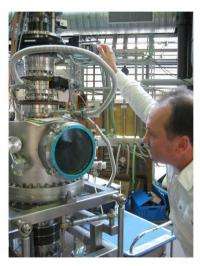Locating the elusive: Scientists observe how material at room temperature exhibits 'multiferroic' properties

German researchers at Helmholtz-Zentrum Berlin (HZB) in close collaboration with colleagues in France and UK, have engineered a material that exhibits a rare and versatile trait in magnetism at room temperature. It's called a "multiferroic," and it means that the material has properties allowing it to be both electrically charged (ferroelectric) and also the ability to be magnetic (ferromagnetic), with its magnetisation controlled by electricity.
This research was based around a material known as barium titanate (BaTiO3), a ferroelectric crystal that is promising to have potential uses in multi-state data storage while being cost effective. Their paper titled, "Interface-induced room-temperature multiferroicity in BaTiO3" appears now in Nature Materials.
"We've shown a way where you can obtain a multiferroic at room temperature," said Sergio Valencia, post doc researcher at HZB, referring to the scarcity of room temperature examples. "Barium titanate is ferromagnetic, so it means you have a net-magnetic moment you can really control by an electric field.
The idea is that you can apply a voltage to the ferroelectric reversing the ferroelectric polarization which in turn affects the magnetization of your film [BaTiO3]. You can use this for example to write bits of information in memories of computers by only applying voltages, which is much cheaper in terms of power than traditionally applying magnetic fields."
It is this ability to control the material's magnetism and to be able to do it at room temperatures which makes this multiferroic potentially more cost-effective compared to other current multiferroic materials, which require complex arrangements to work.
Finding these two traits of ferromagnetic and ferroelectric working together in a compound is tricky due to the strange love-hate relationship exhibited by the two phenomena. What a ferromagnetic requires to exist is not the same as what a ferroelectric requires.
Yet strangely, the two compliment each other and share a strong relationship, where one affects the other. The scarcity of these multiferroics however, is a result of this unique phenomenon combined with the few naturally occurring examples.
"They are scarce and the problem is that most of them are multiferroic only at very low temperatures," added Valencia. "Therefore they are not useful for applications. If you have to go to -270 °C for a multiferroic then it's really complicated and expensive to implement them in room temperature working devices."
The researchers witnessed this multiferroic behaviour by investigating magnetic moments of Titanium (Ti) and Oxygen (O) atoms in BaTiO3 by using synchrotron radiation source BESSY II of Helmholtz-Zentrum Berlin. They used a research method known as soft X-ray resonant magnetic scattering.
The team was able to witness the dual traits of both ferroelectric and ferromagnetic in the thin films of BaTiO3. And since BaTiO3 is a non-magnetic ferroelectric material at room temperature, the ferromagnetism was induced by proximity to natural ferromagnets such as iron (Fe) and Cobalt (Co). In order to achieve these results the researchers deposited a ten atom thin film of iron and cobalt on top of a four atom thin BaTiO3 film. "These small thicknesses are indeed required for the implementation of such materials in devices to keep their small size," added Valencia.
More information: S. Valencia et al.: "Interface-induced room-temperature multiferroicity in BaTiO3". Nature Materials, DOI: 10.1038/NMAT3098
Provided by Helmholtz Association of German Research Centres




















